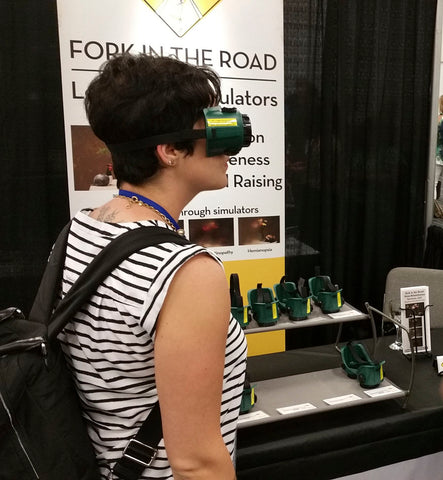Low Vision Simulation Activities
Things to Remember About Simulation
 Although a person with normal vision can never fully comprehend the complexities of life with low vision, wearing a simulator can provide a sense of some of the issues involved.
Although a person with normal vision can never fully comprehend the complexities of life with low vision, wearing a simulator can provide a sense of some of the issues involved.
Often, the wearer is impressed with how much he or she can do; at other times, the wearer finds the simplest task extremely frustrating. Understand that everyone is unique and his or her experience of low vision is unique.
Just because someone has a certain diagnosis does not mean that he or she will see the same, have the same needs or have the same abilities as another person with the same diagnosis. Also, some people with low vision may have a combination of vision impairments, other disabilities, fluctuating vision or a progressive vision condition which can greatly affect their ability to process visual information.
In-service ideas
- Provide the elements of a snack for your group and have them prepare it while wearing simulators. This could involve small buns or rolls, sliced cheese and/or meat, condiments (mustard, mayonnaise) and sliced tomatoes and lettuce.
- Beverages and cups should also be provided and pouring encouraged.
- Having people use salt and pepper, eat some Jell-0, a tossed salad or some macaroni and cheese can be enlightening.
- The experience may be more challenging if the participants have not seen the food and drink on the table before putting on their simulators (they will not have a visual memory to assist them).
- Depending on the situation and the goal of your presentation, it can be very interesting to have a sighted person (without a simulator) help the person who is wearing the simulator with activities such as writing, eating or orientation and mobility.
- Be sure to allow time for participants to discuss their experiences and feelings with the group.
Activities associated with the home
- Watch T.V. Try viewing at 15 ft.(4.6 M), 10 ft.(3 M) and 5 ft.(1.5 M). Read: a letter, a greeting card, a newspaper, a recipe, directions or instruction on a package.
- Look at photographs, or pictures in magazines.
- Pour a cup or glass of soda/water/coffee. Notice if there is a difference when pouring dark liquids into a white cup and when pouring them into a dark cup.
- Dial this number on your phone: (+1) 202-762-1401
- Walk outside and back inside. Notice if your vision changes in different lighting as you move through the doorways.
- Write five items from a grocery list using different pens or pencils. Which ones can you see the best?
- Look at other people. Can you see the features in their face? Can you see what they are wearing? How their hair is done? If they are wearing jewelry or glasses?
Activities associated with offices or commercial/public buildings
- Find the restroom ‑‑ locate the toilet/urinal – find the sink and wash your hands. Notice if a change in lighting made if easier or more difficult to walk in and out of the restroom.
- Take an elevator to another floor ‑‑ get off and find a room where the last two digits are the same as your age ‑‑ return to where you started.
- Use, or pretend to use, the vending machines (soda and food). Find the item you want, locate its selector button(s) or knob, and determine where to insert your money.
- Get a drink from a drinking fountain.
- Make a small purchase from a vendor. You can have a person who is not wearing a simulator pretend to sell you something. Receive change from a $20 bill. Identify coins.
- Ask a receptionist, the doorman, or someone in another office for directions to a room in your building – preferably one that you don’t know.
- Dial this number on your phone: (+1) 202-762-1401
- Walk outside. Notice if your vision changes in different lighting as you move through the doorways.
- Ask a friend to identify himself or herself when they come to talk to you. Look at other people. Can you see the features in their face? Can you see what they are wearing? How their hair is done? If they are wearing jewelry or glasses?
In the News
- See our blog for articles from around the world regarding how our simulators have been used!
- Read about how UW School of Nursing’s Center for Aging Research and Education (CARE) included our vision simulators as part of their "Dementia Friendly Toolkit: Role Play Simulations for Care and Community Settings”
Thanks to Don Golembiewski, MA, CVRT for his suggestions.
